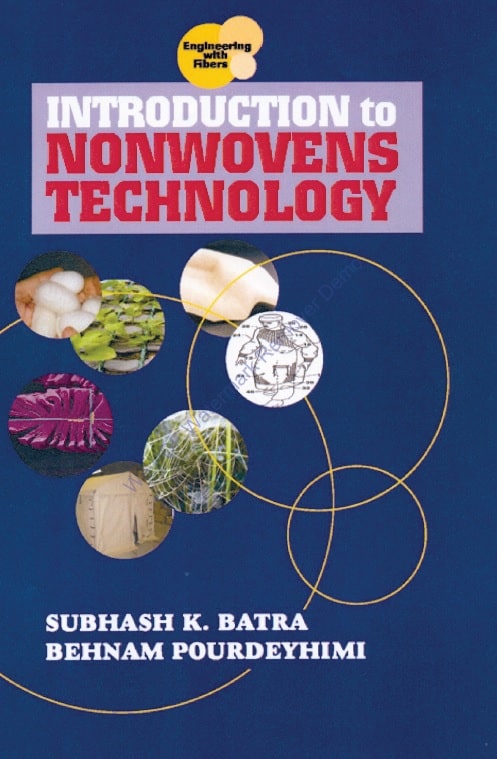
CONTENTS
Foreword xi
Series Preface xiii
Acknowledgements xv
Prologue xvii
PART I. USEFUL PRELIMINARIES
1. Definitions 3
What Is a Nonwoven Fabric? 3
Structural Definitions 8
Advantages of the Structural Definitions 9
The Study of Nonwovens Technology:
An Impressionistic Approach 10
Problems/Exercises 11
2. Structure of Thin Webs: The Orientation
Distribution Function (ODF) . 13
Introduction 13
The Orientation Distribution Function: A Description
of Homogeneous Thin-Web Structure 13
Isotropy vs. Anisotropy 19
A Simple Illustration of the Importance of ODF 20
Influence of ODF: A Few Other Examples 23
Problems/Exercises 24
3. Basic Technologies and Their Augmentations . 27
Problems/Exercises 30
PART II. STAPLE FIBER-BASED TECHNOLOGIES
4. Preparation of Staple Fibers for Web Formation 33
Introduction 33
Opening and Blending of Staple Fiberstock 34
Problems/Exercises 42
5. Staple Fiber Web Formation: Carding . 43
Introduction 43
Basic Elements of the Carding Process 43
Card Clothings and Their Plausible Role 52
Randomizing or Random Rollers: Condensing or
Scrambling Rollers 57
Some Recent Developments 59
Aerodynamic Influences in Carding 59
Batt Formation and Card Feeding 61
Does Carding Individualize Fibers? 66
End Use Products 68
Problems/Exercises 68
6. Staple Fiber Web Formation: Airlay . 71
Introduction 71
Airlay for Non-Wood-Pulp Fibers 71
Airlay for Wood Pulp 78
Application Markets 83
Problems/Exercises 83
PART III. BONDING technologies
7. Needlepunch Bonding 87
Historical Context 87
Needlepunch Bonding 88
Needlepunching Technology 98
Properties of Conventional Needlepunched Fabrics 101
Fibers Used and Potential Markets 106
Special Purpose Needle Looms 107
Problems/Exercises 109
Appendix 110
8. Hydroentanglement Bonding . 113
Historical Context 113
The Core of the Technology 115
Bonding Mechanism and Fiber Characteristics 123
The Degree of Bonding 125
Fabric Properties and Applications 126
Application Markets 127
Problems/Exercises 127
Appendix 8.A 128
Appendix 8.B 129
9. Thermal Bonding . 131
Introduction 131
Prerequisites for Thermal Bonding 132
Bonding Technologies 134
Problems/Exercises 144
9H. Heat and Steam: Concepts, Definitions,
Relevance to Thermal Bonding 147
Introduction 147
Conduction and Its Relevance 149
Convection and Its Relevance 152
Radiation and Its Relevance 153
On Steam and Its Relevance 158
10. Resin/Chemical Bonding 161
Introduction 161
Latex Binders 162
Classes of Latex Binders and Their Characteristics 173
How Does the Bond Form? 176
Thermoset Resins 177
Application Technologies 179
Drying/Curing 184
Application Markets 184
Problems/Exercises 185
PART IV. INTEGRATED TECHNOLOGIES
11. The Wetlay Process . 189
Historical Context 189
The Technology 192
Properties of Wetlaid Nonwovens 199
Application Markets 200
Problems/Exercises 202
12. Melt-Extrusion Technologies: The Spunbond
Process . 203
Introduction 203
Broad Overview: Spunbond Technology 203
Preparation and Web Formation: Evolution 206
Product Characteristics 222
Product Markets 223
Problems/Exercises 224
12P. Polymer/Fiber Physics—A Brief Overview 225
Introduction 225
Preliminary Definitions and Concepts 225
Viscosity 233
About Fiber Spinning and Property Development 235
13. Melt-extrusion Technologies: The Meltblowing
Process . 237
Introduction and Historical Context 237
The Technology 238
Fabric Characteristics 250
Problems/Exercises 250
Appendix 251
14. Fibrillated/Split/Slit Film and Nanoscale
Webs (Flash-spinning, Electro-spinning
and Bicomponent-Based) . 253
Fibrillated/Perforated Film Nonwovens 253
Flash-Spun Nonwovens 269
Electrospun Webs 274
Micro and Nanoscale Fiberwebs via Bicomponent Fibers 281
PART V. WINDING IT UP
15. Integrative Technologies: Stitch-bonding,
Co-forming, Napco, Lamination, Resin-bonding 289
Introduction 289
Stitch-bonding/Stitch-knitting 290
Co-forming Technology 300
NAPCO Technology: 3-D weblinker 302
Lamination as an Integrative Process 304
Resin-bonding as an Integrative Process 306
16. Raw Materials: Properties and Use in
Fiberweb Nonwovens 307
Introduction 307
Manufactured Fibers/Resins 309
Problems/Exercises 330
Index 333
PREFACE
The textile industry has traditionally been the largest user of fibers. As such, fibers have not been seen as engineering materials. This viewpoint, with rare exceptions, has impeded the use of fibers in engineering applications, where their unique characteristics (surface area/volume ratio, slenderness ratio) can provide enhanced performance at optimal cost. The rare exceptions include fiber reinforced composites, fiber optics, space and aerospace applications. The majority of innovations in these areas have come from communities outside the textile industry.
While the Wright Brothers used tightly woven cotton fabrics as the skin for wings of their prototype planes in the early 1900s, fibers did not gain recognition as engineering materials until the latter half of the 20th century. The credit for this development goes primarily to the birth and growth of the manufactured fiber industry, first in the U.S. and Europe, followed by Japan and other Asian countries. The credit also goes to the parallel growth of the nonwovens industry. Even though the textile industry claims the nonwovens industry as one of its components, much of the nonwovens industry, just as the floor coverings industry, does not subscribe to this point of view.
Today, the medical devices industry, the hygiene industry, the civil engineering and building construction industry, the filtration industry, the automotive industry, to name a few, are making strides unimaginable a mere few decades ago. They have learned to engineer high-value products using the unique characteristics of suitable fibers.
The purpose of the Engineering with Fibers series is to elucidate the role of engineering and material science in the use of fibers as engineering materials.
